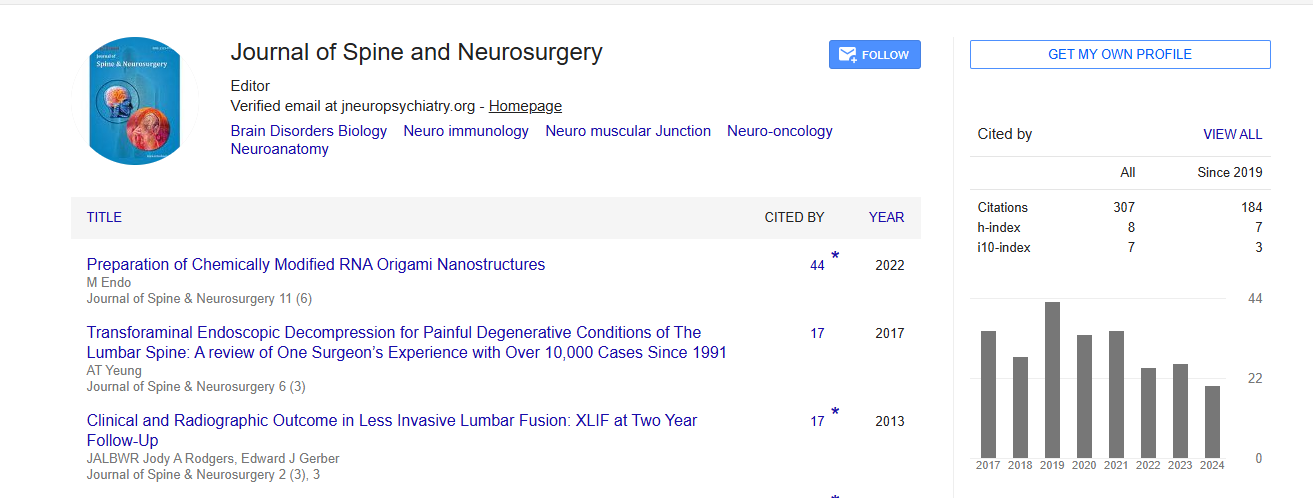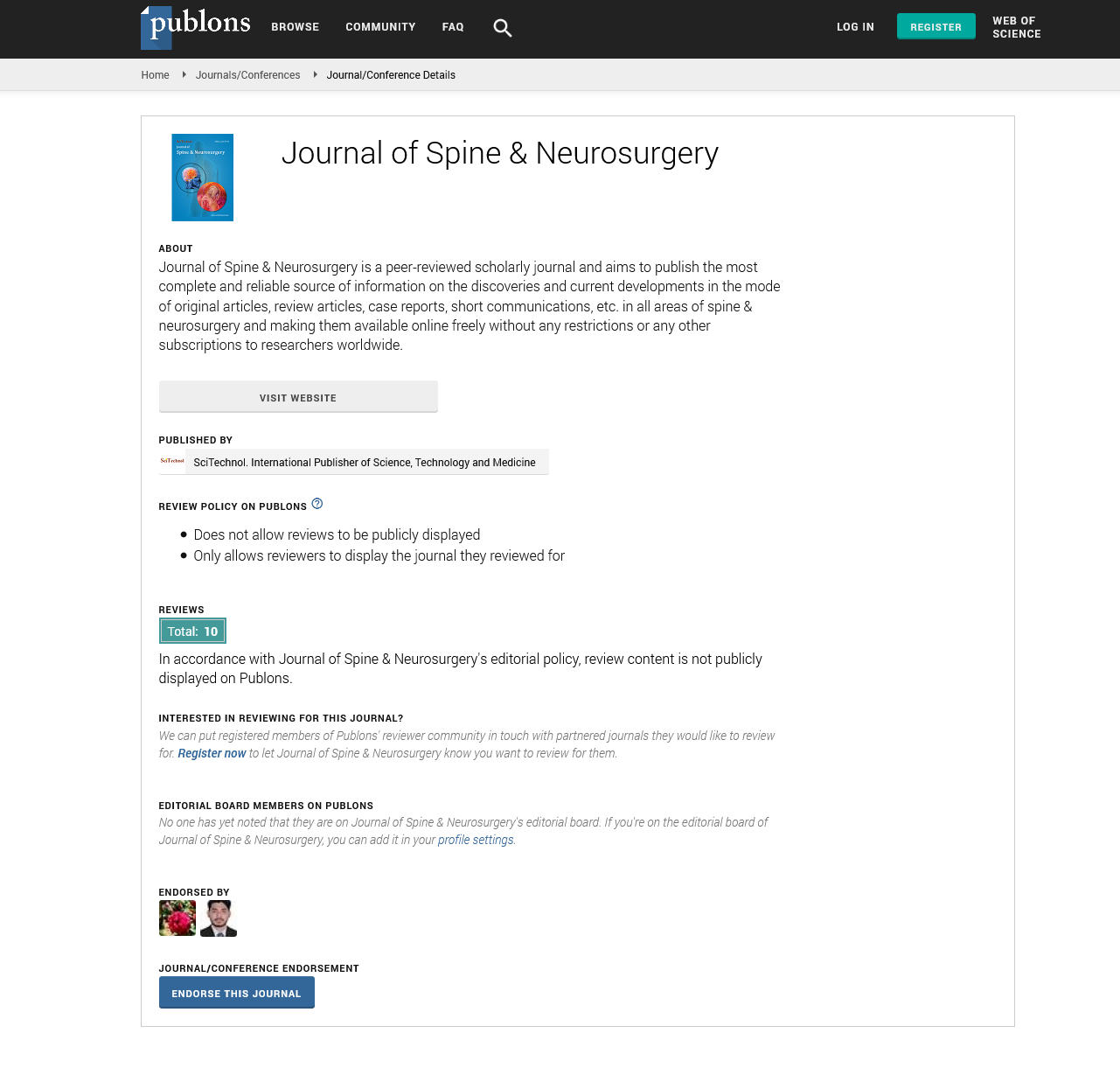Commentary, J Spine Neurosurg Vol: 12 Issue: 6
Sympathetic Arachnoiditis and its Impact on Health
Michelie Nami*
1Department of Surgery, University of Montreal, Quebec, Canada
*Corresponding Author: Michelie Nami,
Department of Surgery, University of
Montreal, Quebec, Canada
E-mail: michelie_001nami@gmail.com
Received date: 27 November, 2023, Manuscript No. JSNS-24-128388;
Editor assigned date: 29 November, 2023, PreQC No. JSNS-24-128388(PQ);
Reviewed date: 14 December, 2023, QC No. JSNS-24-128388;
Revised date: 21 December, 2023, Manuscript No. JSNS-24-128388 (R);
Published date: 28 December, 2023, DOI: 10.4172/2325-9701.1000184.
Citation: Nami M (2023) Sympathetic Arachnoiditis and Its Impact on Health. J Spine Neurosurg 12:6.
Description
Arachnoiditis is a rare but potentially debilitating condition that affects the arachnoid, one of the membranes surrounding the spinal cord and brain. Characterized by inflammation of the arachnoid, this disorder can lead to a variety of symptoms, including chronic pain and neurological abnormalities. This aims to unravel the complexities of arachnoiditis, exploring its causes, symptoms, diagnosis, and available management strategies. The arachnoid is one of the three membranes (meninges) that cover and protect the brain and spinal cord. It lies between the dura mater (outermost layer) and the pia mater (innermost layer). Arachnoiditis is characterized by inflammation of the arachnoid membrane. In some cases, this inflammation may progress to the formation of scar tissue or fibrosis.
Causes of arachnoiditis
Infections, particularly those affecting the spinal cord and surrounding tissues, can lead to arachnoiditis. Bacterial or viral infections, such as tuberculosis or meningitis, are potential triggers. Certain spinal surgeries, myelograms, or invasive spinal procedures can inadvertently cause inflammation of the arachnoid, leading to arachnoiditis. Trauma to the spine, such as fractures or severe spinal injuries, may contribute to the development of arachnoiditis. Exposure to certain chemical irritants, including myelogram dyes, epidural steroid injections, or some preservatives in intrathecal medications, can increase the risk of arachnoiditis. Chronic compression of the spinal nerves or arachnoid due to conditions like spinal stenosis can contribute to the development of arachnoiditis.
Symptoms of arachnoiditis
Persistent, severe pain is a symptom of arachnoiditis. The pain may be localized to the lower back and may radiate down the legs. Arachnoiditis can cause sensory disturbances, including numbness, tingling, or a "pins and needles" sensation in the affected areas. Individuals with arachnoiditis may experience muscle cramps, spasms, or twitching, contributing to further discomfort. Dysfunction of the bladder and bowel may occur, leading to issues such as incontinence or difficulty voiding. Arachnoiditis can cause a range of neurological abnormalities, including weakness, loss of reflexes, and difficulty walking.
Diagnosis of arachnoiditis
Diagnosis begins with a thorough clinical evaluation, including a detailed medical history and physical examination to assess symptoms and neurological function. Imaging studies, such as MRI or CT scans, may be conducted to visualize the spinal cord and surrounding structures, helping identify inflammation or abnormalities. Electromyography (EMG) and nerve conduction studies may be used to assess nerve function and identify abnormalities associated with arachnoiditis. Myelograms, although rare due to their association with arachnoiditis development, may be used to visualize the spinal cord and surrounding structures by injecting a contrast dye.
Management and treatment
Pain management is a central aspect of arachnoiditis treatment. Medications, physical therapy, and psychological support may be employed to address chronic pain. Treatment may be tailored to address specific symptoms, such as medications for neuropathic pain, muscle relaxants for spasms, and interventions to manage bladder or bowel dysfunction. Avoiding additional spinal procedures or interventions that could exacerbate inflammation is essential in managing arachnoiditis
Conclusion
Arachnoiditis poses unique challenges due to its impact on the delicate structures surrounding the spinal cord. While there is no cure for this condition, a comprehensive and multidisciplinary approach to management can help improve the quality of life for individuals affected by arachnoiditis. Ongoing research and advancements in treatment modalities may provide further insights into this complex disorder, offering hope for better outcomes and enhanced support for those navigating the challenges of arachnoiditis. Supportive therapies, including physical therapy, occupational therapy, and counseling, can contribute to overall well-being and help individuals cope with the challenges of living with arachnoiditis. Surgical interventions are generally not recommended for arachnoiditis due to the risk of exacerbating symptoms. However, in specific cases, decompressive surgery or other procedures may be considered after careful evaluation.
 Spanish
Spanish  Chinese
Chinese  Russian
Russian  German
German  French
French  Japanese
Japanese  Portuguese
Portuguese  Hindi
Hindi 
